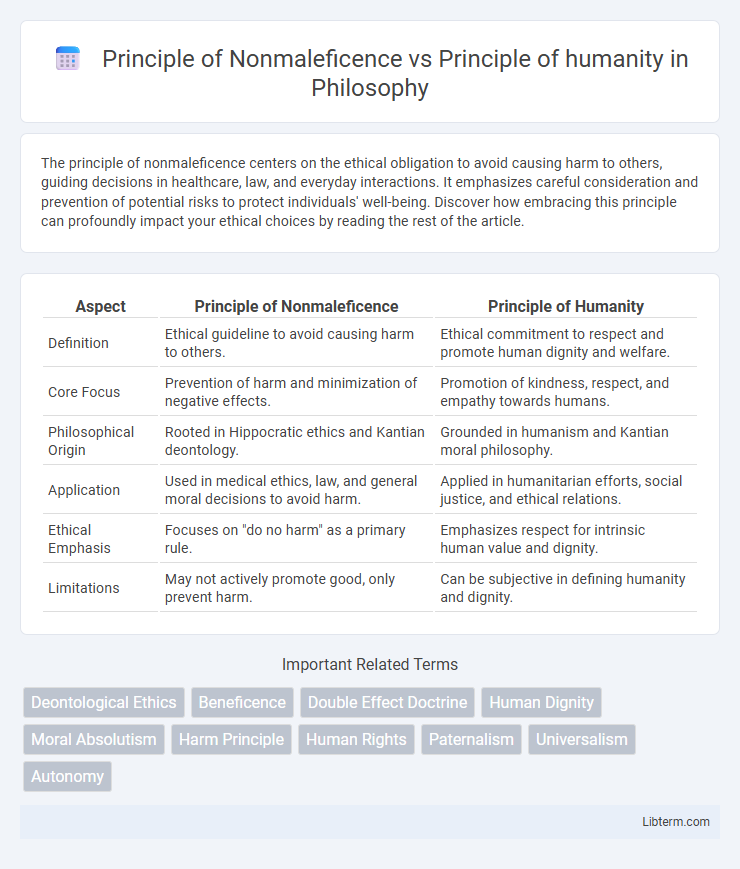The principle of nonmaleficence centers on the ethical obligation to avoid causing harm to others, guiding decisions in healthcare, law, and everyday interactions. It emphasizes careful consideration and prevention of potential risks to protect individuals' well-being. Discover how embracing this principle can profoundly impact your ethical choices by reading the rest of the article.
Table of Comparison
| Aspect | Principle of Nonmaleficence | Principle of Humanity |
|---|---|---|
| Definition | Ethical guideline to avoid causing harm to others. | Ethical commitment to respect and promote human dignity and welfare. |
| Core Focus | Prevention of harm and minimization of negative effects. | Promotion of kindness, respect, and empathy towards humans. |
| Philosophical Origin | Rooted in Hippocratic ethics and Kantian deontology. | Grounded in humanism and Kantian moral philosophy. |
| Application | Used in medical ethics, law, and general moral decisions to avoid harm. | Applied in humanitarian efforts, social justice, and ethical relations. |
| Ethical Emphasis | Focuses on "do no harm" as a primary rule. | Emphasizes respect for intrinsic human value and dignity. |
| Limitations | May not actively promote good, only prevent harm. | Can be subjective in defining humanity and dignity. |
Understanding the Principle of Nonmaleficence
The Principle of Nonmaleficence emphasizes the ethical obligation to avoid causing harm to others, serving as a foundational guideline in medical and professional practices. It requires practitioners to prioritize patient safety and prevent actions that may lead to injury or suffering, aligning closely with ethical standards advocating for beneficence and respect. Understanding this principle involves recognizing its critical role in maintaining trust, minimizing risks, and promoting overall well-being in healthcare and human interactions.
Exploring the Principle of Humanity
The Principle of Humanity emphasizes respect for human dignity, seeking to promote well-being and alleviate suffering through compassionate and ethical actions. Unlike the Principle of Nonmaleficence, which focuses on avoiding harm, the Principle of Humanity actively encourages kindness and positive engagement with others. Healthcare professionals applying the Principle of Humanity prioritize empathy, moral integrity, and the holistic welfare of patients in clinical decision-making.
Historical Origins of Both Principles
The Principle of Nonmaleficence, rooted in the Hippocratic Oath dating back to ancient Greece, emphasizes the ethical obligation to avoid causing harm in medical practice. The Principle of Humanity emerged from Enlightenment philosophy and human rights movements, highlighting the inherent dignity and respect owed to all individuals. Both principles historically underpin ethical standards but focus respectively on preventing harm and promoting respect for human worth.
Key Differences Between Nonmaleficence and Humanity
The Principle of Nonmaleficence emphasizes the obligation to avoid causing harm, prioritizing safety and preventing injury or suffering. In contrast, the Principle of Humanity centers on respect, compassion, and the intrinsic dignity of human beings, promoting positive actions that honor human rights and welfare. Nonmaleficence restricts harmful interventions, while Humanity encourages proactive care and empathetic treatment.
Ethical Foundations and Philosophical Perspectives
The Principle of Nonmaleficence, rooted in the Hippocratic tradition, emphasizes the ethical foundation of "do no harm," prioritizing the prevention of harm in medical and moral decision-making. In contrast, the Principle of Humanity is anchored in Kantian ethics, advocating for respect and dignity toward others as autonomous moral agents, focusing on beneficence and the intrinsic worth of human beings. Philosophical perspectives highlight Nonmaleficence as a deontological constraint limiting actions, whereas Humanity centers on positive obligations to promote well-being and uphold human rights.
Applications in Healthcare and Medicine
The Principle of Nonmaleficence in healthcare mandates that medical professionals avoid causing harm to patients, emphasizing practices like minimizing risks during treatment and preventing medical errors. The Principle of Humanity centers on respecting patients' dignity and promoting their well-being through compassionate care and patient-centered communication. Both principles guide ethical decision-making in clinical settings, balancing harm prevention with empathy to enhance patient outcomes and trust.
Challenges in Balancing Both Principles
Balancing the Principle of Nonmaleficence, which mandates avoiding harm, with the Principle of Humanity, emphasizing compassion and respect for human dignity, presents significant ethical challenges in medical practice. Conflicts arise when interventions intended to relieve suffering might cause unintended harm or when strict adherence to nonmaleficence limits empathetic care decisions. Navigating these principles requires nuanced judgment to optimize patient outcomes while upholding ethical integrity.
Case Studies Illustrating Conflicts
Case studies highlighting conflicts between the Principle of Nonmaleficence and the Principle of Humanity often involve medical ethics dilemmas where healthcare providers must balance avoiding harm with respecting patient dignity. For example, in end-of-life care, decisions about withholding or withdrawing life-sustaining treatment demonstrate tension between not causing harm (Nonmaleficence) and promoting patient well-being and compassion (Humanity). These cases require careful ethical analysis to navigate competing obligations while prioritizing patient-centered outcomes.
Practical Implications in Policy Making
The Principle of Nonmaleficence mandates policymakers to avoid actions causing harm, ensuring regulations protect public welfare and minimize risk. The Principle of Humanity emphasizes respect for human dignity and rights, guiding policies that promote fairness, compassion, and social justice. Balancing these principles in policy making requires rigorous risk assessment and ethical deliberation to create frameworks that prevent harm while fostering human flourishing.
Future Directions for Ethical Frameworks
Future directions for ethical frameworks emphasize integrating the Principle of Nonmaleficence, which mandates avoiding harm, with the broader Principle of Humanity that promotes respect, dignity, and compassion in decision-making. Emerging models aim to balance these principles by developing context-sensitive guidelines that prioritize harm reduction while fostering human welfare in healthcare, technology, and policy. Advancements in AI ethics and biomedical research highlight the need for dynamic frameworks that adapt to complex dilemmas by embedding both nonmaleficence and humanity as core operational values.
Principle of Nonmaleficence Infographic

 libterm.com
libterm.com